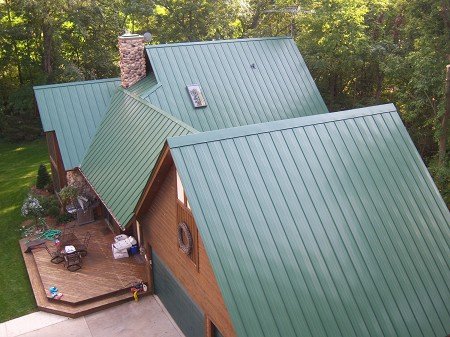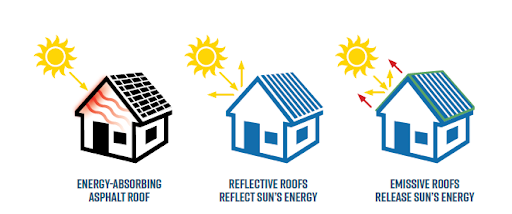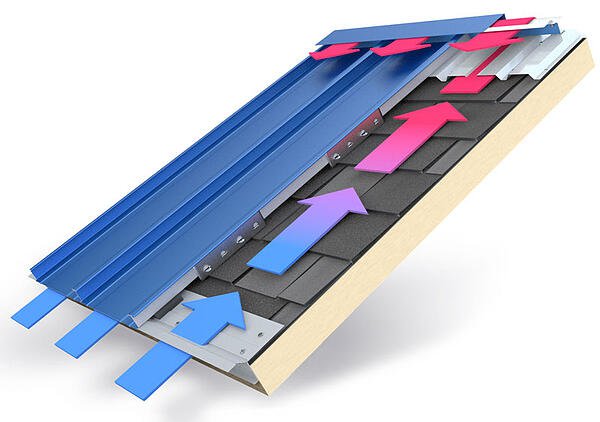Share
Or copy this URL:
https://www.metalroofing.com/news/common-misconceptions-about-heat-absorption-metal-roofs/

Posted by McElroy Metal
There are a lot of people out there who think that metal roofs will make their homes hotter.
That’s a myth, but it’s a myth that’s easy to understand. When it’s really hot outside and you touch a doorknob, for example, the doorknob will probably be pretty warm - maybe a lot warmer than its surroundings!
However, we’re going to debunk the myth about heat and metal roofs today, and we’re going to do it by looking at all the factors that make metal roofs excellent for cooling your home. That’s right - metal roofs will actually keep your home cooler than other roofing materials like asphalt. Let’s find out why:
That means how conductive your roof is depends heavily on which metals were used in its construction.
Well, that’s not quite accurate - as we’ll talk about in a later section. There’s something else to consider, though - what if you have a material that can absorb a lot of heat, but has relatively low conductivity?
Think about asphalt on a hot day. Asphalt has very low conductivity compared to metal, but if you’re standing on asphalt barefoot, you’ll still get burned. What’s more, that asphalt will slowly release all that heat - it’s one of the biggest contributors to the urban heat island effect.
At night, your metal roof’s high heat conductivity means most of the heat will escape rapidly. Asphalt roofs, on the other hand, will only very slowly release heat - which can contribute to your home being warmer at night.

With all this talk of heat conductivity, you might be thinking it’s the most important consideration when choosing a roofing material.
Not so.
The biggest contributor to a roof’s heat gains is how much radiant heat that roof absorbs - in other words, how much heat it absorbs from the sun’s rays. Materials that are good at reflecting radiant heat are much better for keeping your home cool.
That’s the biggest advantage metal roofs have when it comes to heat gain - they reflect radiant energy much better than other roofing materials, like asphalt shingles. How well metal roofs reflect the sun’s rays will depend, in part, on what color they are.
For those of you who didn’t know, metal roofs come in all sorts of different colors - the darker the color you choose, the more radiant energy the roof will absorb. For that reason, many people who are looking to keep their home cool opt for lighter colors.

Apologies to the metalheads out there - when it comes to roofing system components, there’s more than just metal.
Your roof cladding is metal, but the other components of your roof probably aren’t. The joists are most likely made of wood and your insulation will be made from another material entirely.
All these materials will work together to keep your home cool. Your insulation will play one of the biggest roles in determining how warm your home gets - when a home is properly insulated, the heat from a metal roof will escape outside, not inside.
To help keep your home cool in the summertime, some metal roof installers will include above sheathing ventilation (ASV). This system allows air to flow between your roof sheathing and the insulation, then get released. That means less heat energy is absorbed by your home.
Your home’s overall ventilation is also important. Having a properly ventilated attic means heat that would be absorbed by the rest of your home is instead released back outside.
Infrared roof inspections and energy audits can help you find weak points in your roof’s insulation - those are points where heat transfer looks different than it does on the rest of your roof.
This all to say, if you find your home is hotter than you’d like, don’t be so quick to blame the metal - it’s likely that your roof’s insulation or your attic’s ventilation is the problem!
Now you know the truth - metal roofs are actually good at keeping your home cooler, since they reflect the sun’s rays. Thermal conductivity isn’t everything, and higher conductivity can actually be a good thing. When your home is getting too hot, look at your insulation and your cooling system - not at your metal roof!
There are a lot of people out there who think that metal roofs will make their homes hotter.
That’s a myth, but it’s a myth that’s easy to understand. When it’s really hot outside and you touch a doorknob, for example, the doorknob will probably be pretty warm - maybe a lot warmer than its surroundings!
However, we’re going to debunk the myth about heat and metal roofs today, and we’re going to do it by looking at all the factors that make metal roofs excellent for cooling your home. That’s right - metal roofs will actually keep your home cooler than other roofing materials like asphalt. Let’s find out why:
Misconception #1: All metals are made equally
Different metals conduct heat differently. You could, for example, have a roof made entirely of copper. A totally copper roof would be an excellent conductor of heat. Stainless steel, on the other hand, is a very poor conductor of heat.That means how conductive your roof is depends heavily on which metals were used in its construction.
Misconception #2: High heat conductivity is bad
Thinking that high conductivity is bad makes sense - after all, that heat is going to transfer its way into your home, right?Well, that’s not quite accurate - as we’ll talk about in a later section. There’s something else to consider, though - what if you have a material that can absorb a lot of heat, but has relatively low conductivity?
Think about asphalt on a hot day. Asphalt has very low conductivity compared to metal, but if you’re standing on asphalt barefoot, you’ll still get burned. What’s more, that asphalt will slowly release all that heat - it’s one of the biggest contributors to the urban heat island effect.
At night, your metal roof’s high heat conductivity means most of the heat will escape rapidly. Asphalt roofs, on the other hand, will only very slowly release heat - which can contribute to your home being warmer at night.
Misconception #3: Heat conductivity is the be all and end all

With all this talk of heat conductivity, you might be thinking it’s the most important consideration when choosing a roofing material.
Not so.
The biggest contributor to a roof’s heat gains is how much radiant heat that roof absorbs - in other words, how much heat it absorbs from the sun’s rays. Materials that are good at reflecting radiant heat are much better for keeping your home cool.
That’s the biggest advantage metal roofs have when it comes to heat gain - they reflect radiant energy much better than other roofing materials, like asphalt shingles. How well metal roofs reflect the sun’s rays will depend, in part, on what color they are.
For those of you who didn’t know, metal roofs come in all sorts of different colors - the darker the color you choose, the more radiant energy the roof will absorb. For that reason, many people who are looking to keep their home cool opt for lighter colors.
Misconception #4: Metal is all there is

Apologies to the metalheads out there - when it comes to roofing system components, there’s more than just metal.
Your roof cladding is metal, but the other components of your roof probably aren’t. The joists are most likely made of wood and your insulation will be made from another material entirely.
All these materials will work together to keep your home cool. Your insulation will play one of the biggest roles in determining how warm your home gets - when a home is properly insulated, the heat from a metal roof will escape outside, not inside.
To help keep your home cool in the summertime, some metal roof installers will include above sheathing ventilation (ASV). This system allows air to flow between your roof sheathing and the insulation, then get released. That means less heat energy is absorbed by your home.
Your home’s overall ventilation is also important. Having a properly ventilated attic means heat that would be absorbed by the rest of your home is instead released back outside.
Infrared roof inspections and energy audits can help you find weak points in your roof’s insulation - those are points where heat transfer looks different than it does on the rest of your roof.
This all to say, if you find your home is hotter than you’d like, don’t be so quick to blame the metal - it’s likely that your roof’s insulation or your attic’s ventilation is the problem!
Now you know the truth - metal roofs are actually good at keeping your home cooler, since they reflect the sun’s rays. Thermal conductivity isn’t everything, and higher conductivity can actually be a good thing. When your home is getting too hot, look at your insulation and your cooling system - not at your metal roof!